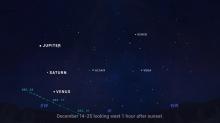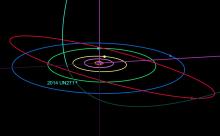Listen to today's episode of StarDate on the web the same day it airs in high-quality streaming audio without any extra ads or announcements. Choose a $8 one-month pass, or listen every day for a year for just $30.
You are here
Orionid Meteors
The Orionid meteor shower is building toward its peak the next couple of nights. At its best, you might see a dozen or more “shooting stars” per hour — glowing sparks high in the sky.
Those sparks are debris from Comet Halley. As it approaches the Sun, some of the ice at its surface vaporizes. That releases solid particles of rock and dust. Those bits of debris spread out along Halley’s path.
Earth intersects that path a couple of times every year. When it does, it sweeps up some of the comet dust. The particles slam into the atmosphere at tens of thousands of miles per hour. They quickly vaporize, forming the glowing trails known as meteors.
The brightness and duration of each meteor depends on the size and composition of the particle. Larger particles form brighter trails. The brightest are formed by bits of debris the size of a plum or larger. But most are no bigger than pebbles.
The Orionids aren’t named for Halley’s comet. Instead, the name indicates where the meteors appear to enter the atmosphere — near a star in Orion. But you don’t have to look toward the constellation to see the meteors — they can blaze across any part of the sky.
To watch the shower, find a dark, safe viewing spot far from city lights. The best viewing time is in the hours before dawn. The Moon will be in view for part of that time, but it’s a waning crescent, so most of the meteors will shine through.
Script by Damond Benningfield





